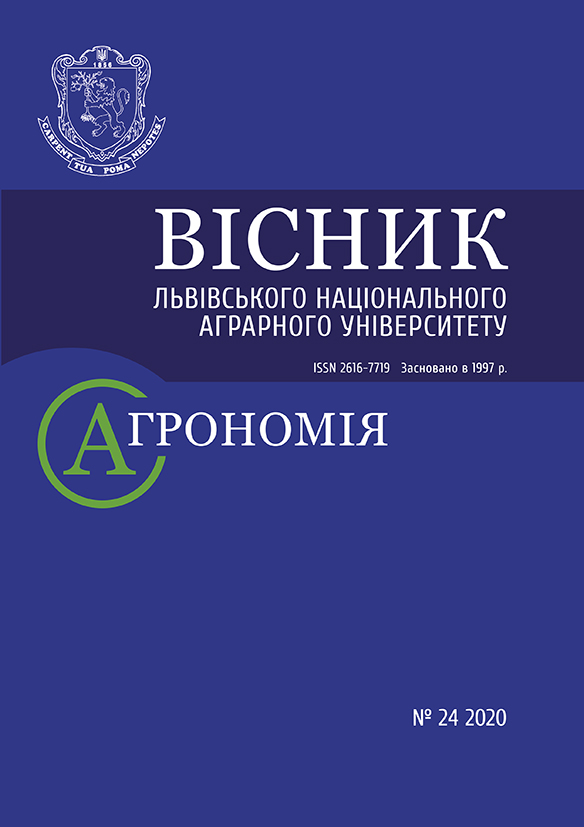Visnyk LNAU: Agronomy 2018 №22(2): 127-130
ENERGY EVALUATION OF THE EFFECTIVENESS OF LIQUID ORGANIC-MINERAL FERTILIZERS IN GROWING SPRING BARLEY
Skrylnyk Ie., Doctor of Agricultural Sciences
Artemyeva К., Post-graduate Student
National Scientific Center «Institute for soil science and agrochemistry research named after O.N. Sokolovsky»
https://doi.org/10.31734/agronomy2018.02.127
Annotation
Results of a research of power efficiency of application the carbamide-ammonium nitrate (CAN) and liquid organo-mineral fertilizers (OMF) are given at cultivation of spring barley of a grade Parnassus. It is established that the integrated application of liquid OMF that by efficiency don't concede to system with introduction of the CAN mineral fertilizers was an energy saving factor in technology of cultivation of spring barley.
The size of total energy costs of production for each option of experience changed depending on performance of necessary operations and varied from 20,80 to 23,45 GJ on 1 hectare of crops. I got the greatest on options with complex introduction of liquid OMF where made 22,12–23,45 GJ.
The volume of thecontent of energy in the crop of spring barley depended on indicators of content of solid and productivity of culture which has developed under the influence of the introduced fertilizers. The smallest amount of energy has been saved up in production in option with introduction of CAN40 where contents her in grain and straw I have made 68,89 GJ/ha. Increase in level of productivity owing to complex application of liquid OMF promoted growth of an energy output with a harvest on these options in 77,64–89,18 GJ/ha.
On all options of experience coefficients of energy efficiency (Kee)>2 have been received that demonstrates approach of technology of cultivation of spring barley to energy saving. On options with introduction of CAN the coefficient of energy efficiency was at the level of 3,31–3,60 units and is in an interval 3–3,5 that corresponds to the average level of efficiency. The highest coefficient of Kee≥3,5 was on options with complex introduction of liquid OMF, changed depending on structure and frequency of application of fertilizers and was at the level of 3,51–3,80 units that on 0,20 and 0,49 units I exceeded the corresponding indicator calculated for option with the smallest in experience of productivity of grain.
Key words
liquid organo-mineral fertilizers, carbamide-ammonium nitrate, energy efficiency, total energy costs, content of energy in the crop, coefficient of energy efficiency, spring barley
Full text
Link
- Bondarchuk A. V. Economic aspects of improving the energy efficiency of agricultural production: monograph. Luhans'k: Elton–2, 2008. С. 120.
- Оdum H. T. Energetics of world food production. The World Food Problem.1967.V. 3.P. 55–94.
- Buha V. K., Dobush H. F., Mytskevych A. A. Energy intensity of agricultural production: monograph. Minsk: Uradzhay, 1992. С.128.
- Tarariko Yu. O., Nesmashna O. Yu., Berdnikov O. M., Hlushchenko L. D., Lychuk H. I. Bioenergy Evaluation of agricultural production. Kyiv: Agrarian science, 2005. 200 p.
- Medvedovs'kyi O. K., Ivanenko P. I. Energy analysis of intensive technologies in agricultural production. Kyiv: Urozhay, 1988. С. 208.
- Buzovs'kyi Ye. A., Vytvyts'ka O. D., Skrypnychenko V. A. Innovations in the assessment of energy efficiency and energy intensity of agricultural production. Ahroinkom. 2008. № 7–10. С. 50–56.
- Hryshko V. V., Perebyynis V. I., Rabshtyna V. M. Energy saving in agriculture (economy, organization, management). Poltava, 1996. 280 p.
- Dospekhov B. A. Field experiment method (with basics of statistical processing of research results). 5-е yzd. Moscow: Ahropromyzdat, 1985. 351 p.
- Vasylyuk H. V., Bohdevych Y. M., Klebanovych N. V., Kozlovs'kyi V. S. Method of determination of energy efficiency of mineral, organic and calcareous fertilizers application. Mynsk, 1996. 51 p.
- Zinchenko O. I., Korotyeyev A. V., Kalins'ka S. M. Crop production: a workshop. Vinytsya: Nova Knyha, 2008. С. 536.



